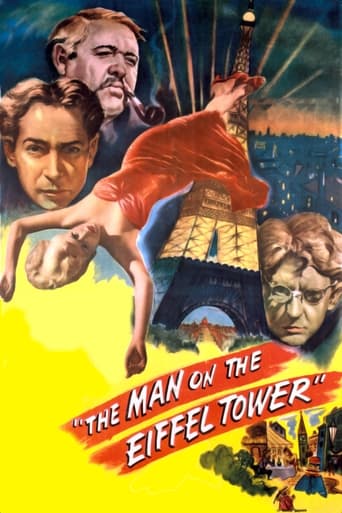«ПАРИЖ, такой как вы никогда его не видели!»
"The Man on the Eiffel Tower," a 1949 film noir, is a captivating blend of suspense and psychological intrigue, produced by A & T Film Productions, Inc., and RKO Radio Pictures. Set against the iconic backdrop of Paris, the film follows the story of a desperate man, played by the enigmatic Charles Laughton, who becomes embroiled in a murder investigation. The film's unique selling point is its use of the Eiffel Tower not just as a setting, but as a central character in the narrative, symbolizing the heights of ambition and the depths of despair. Directed by Burgess Meredith, this film stands out for its innovative use of location and its compelling portrayal of a man on the edge. The plot revolves around a complex web of deceit and betrayal, as Laughton's character navigates the treacherous waters of a murder mystery. The film's noir elements are enhanced by the stark black-and-white cinematography, which captures the moody atmosphere of post-war Paris. The supporting cast, including Franchot Tone and Burgess Meredith, deliver performances that add depth and nuance to the story, making the film a rich tapestry of human emotions and moral dilemmas. The screenplay, adapted from the novel "La Tête d'un Homme" by Georges Simenon, is taut and gripping, keeping audiences on the edge of their seats. One of the most striking aspects of "The Man on the Eiffel Tower" is its use of the Eiffel Tower as a metaphor for the protagonist's internal struggle. The tower's looming presence in the film serves as a constant reminder of the heights to which the character aspires, as well as the potential fall from grace that awaits him. This thematic use of the setting elevates the film beyond a simple murder mystery, turning it into a profound exploration of human nature and the consequences of one's actions. Produced in both France and the United States, "The Man on the Eiffel Tower" is a testament to the power of international collaboration in cinema. The film's blend of French and American sensibilities creates a unique cinematic experience that transcends cultural boundaries. Despite its modest budget, the film's ambitious scope and artistic vision make it a standout in the film noir genre, deserving of a place in the annals of cinematic history.
Год1949
Продолжительность97 мин
Жанрытриллер
Страны производстваFranceUnited States of America

